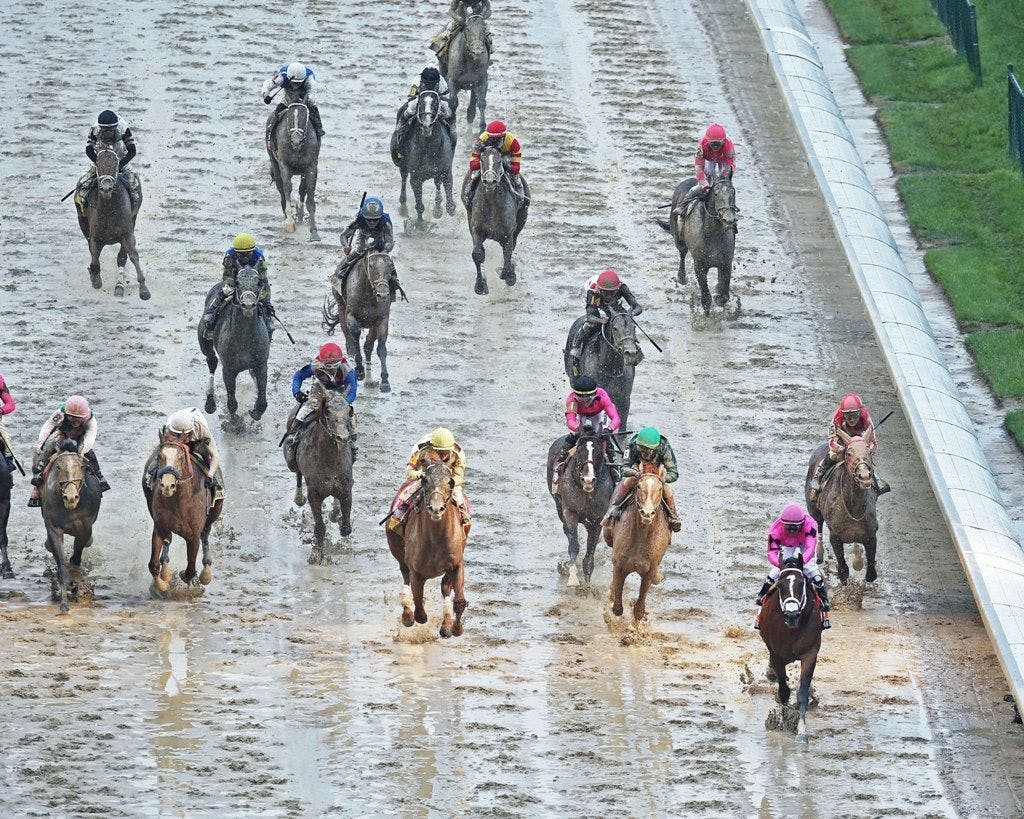What happens when a horse race is "off the turf?"

Coady Photography
Perhaps you’ve heard of horse races being taken “off the turf.” But unless you’re familiar with racing lingo and the broad workings of the sport, the meaning of the phrase isn’t necessarily obvious.
Let’s explore what happens when a horse race is taken off the turf.
What does “off the turf” mean?
In North America, horse races taken place across three different surfaces: dirt, synthetic, and turf. Of the three, turf courses are the most delicate, since they’re comprised of living grass and can’t be resurfaced the same way as loose materials.
What is a turf course?
— TwinSpires Racing 🏇 (@TwinSpires) March 3, 2022
Great Question...
Let's ask @J_Keelerman ⬇️ https://t.co/YH73NuNIYk
As a result, turf courses aren’t used as heavily during wet weather, when the ground is soft and horse hooves readily dig divots in the course. If a heavy rainstorm strikes on a day when turf racing is scheduled, it’s common for the turf races to be taken “off the turf” and contested over dirt or synthetic instead.
What are the side effects of racing off the turf?
When a race is switched from turf to dirt or synthetic, it’s common to see a multitude of scratches. After all, turf horses enter turf races, and they’re not necessarily suited to racing on other surfaces.
On the other hand, sometimes an off-the-turf race can gain an entry or two. If there’s rain in the forecast when entries are drawn, sometimes horses are entered for the “main-track only,” as denoted by the abbreviation “MTO” in the entries. These also-eligible runners scratch if the race stays on turf, but are allowed to compete if there’s a surface switch.
Typically, decisions to shift a race (or races) off the turf are announced prior to the start of a race card. But if bad weather prompts a switch after racing is underway, there are rules (which vary by state) to determine how betting is affected as far as refunds and payoffs are concerned.
How do I identify an off-the-turf race?
It’s easy to determine when a race has been rained off the turf. The condition of the turf course (readily viewable on simulcast feeds and betting platforms) will be listed as “off,” perhaps with numbers indicating exactly which races have been rained off the turf.
After the races have been run, official result charts will likewise indicate that an off-the-turf race was conducted on dirt or synthetic after originally being scheduled for turf. Finally, Brisnet Ultimate Past Performances mark off-the-turf races with an “X” enclosed in a circle, rather than the usual “T” in a circle designating turf races.

If a racetrack offers dirt and turf racing, you can assume an off-the-turf race is contested on dirt. If the track has synthetic and turf surfaces, an off-the-turf contest is naturally transferred to synthetic. As of 2022, Gulfstream Park is the only North American racetrack offering racing on three surfaces (dirt, turf, and synthetic Tapeta), so consulting official sources (such as industry database Equibase) may be the only way to confirm with 100% accuracy whether a turf race has been transferred to dirt or Tapeta.
Tips for betting off-the-turf races
If a race has been rained off the turf, it’s wise to disregard the morning line odds and assume betting will unfold in a very different manner. A logical favorite on turf might be a longshot on dirt, while a 20-1 longshot on turf might have a much stronger chance on dirt.
With this in mind, scour the past performances looking for horses with encouraging form over the new surface. Bring pedigree handicapping into the fold, including sire stats and dam stats. Which of the turf horses have the pedigrees to succeed on dirt or synthetic? Which jockeys ride well on dirt?
Can a horse's sire indicate which race conditions he or she will relish?@J_Keelerman certainly thinks so!
— TwinSpires Racing 🏇 (@TwinSpires) September 29, 2021
He explains 👇 https://t.co/6F0AeqAzs6
Consider also that a race transferred from turf to dirt or synthetic can be weaker than a similar race that takes place on dirt or synthetic. The off-the-turf race will be stacked with turf horses running over a less-than-optimum surface, whereas a regular dirt or synthetic race will attract horses truly suited to the surface. If a turf horse wins a Grade 2 stakes transferred from turf to dirt, that doesn’t mean the turf horse is truly a Grade 2-caliber dirt horse—he may have simply handled the footing better than the other turf horses.
Now that you’re up to speed on the details of off-the-turf racing, you’ll be prepared if wet weather strikes and the turf races you’d planned to play switch to a different surface.
ADVERTISEMENT



